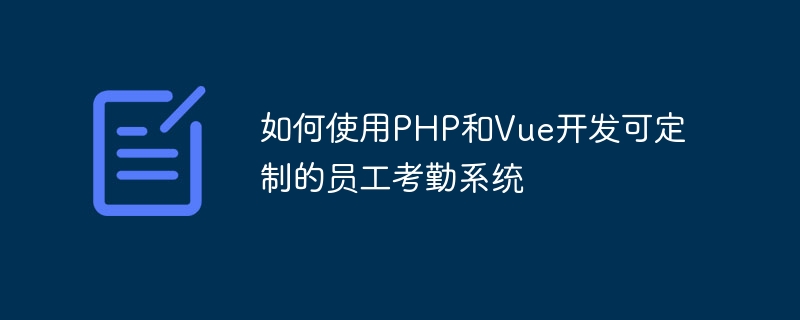Home >Backend Development >PHP Tutorial >How to develop a customizable employee attendance system using PHP and Vue
How to develop a customizable employee attendance system using PHP and Vue
- WBOYOriginal
- 2023-09-25 08:33:10573browse

How to use PHP and Vue to develop a customizable employee attendance system
With the continuous development of technology, the demand for employee attendance systems is increasing day by day. In order to meet the individual needs of different enterprises, it has become very important to develop a customizable employee attendance system. This article will introduce how to use PHP and Vue to develop a customizable employee attendance system and provide specific code examples.
- System requirements analysis and design
First, we need to conduct system requirements analysis and design. According to the needs of different enterprises, the functional modules that the system needs to include can be determined, such as employee information management, attendance record management, attendance report generation, etc. At the same time, the interface design and interaction method of the system also need to be determined. During the design phase, full consideration must be given to the scalability and customization of the system.
- System Architecture Design
In terms of system architecture design, we chose to use PHP as the back-end language and Vue as the front-end framework. PHP is a popular server-side scripting language with a wide range of application areas and rich development resources. Vue is a lightweight JavaScript framework that facilitates front-end development and management of user interfaces.
We can divide the system into two parts: front-end and back-end. The front end is mainly responsible for the display of the user interface and the processing of user operations, while the back end is responsible for interaction with the database and processing of business logic.
- Employee Information Management Module
In the employee information management module, we can use PHP to develop a back-end interface to provide the functions of adding, modifying, deleting and querying employee information. . The following is a simple example implemented using PHP:
// 增加员工信息
function addEmployee($name, $age, $department) {
// 数据库插入操作
// ...
}
// 修改员工信息
function updateEmployee($id, $name, $age, $department) {
// 数据库更新操作
// ...
}
// 删除员工信息
function deleteEmployee($id) {
// 数据库删除操作
// ...
}
// 查询员工信息
function getEmployee($id) {
// 数据库查询操作
// ...
}In the Vue front-end, you can use the Axios library to call the back-end interface. The following is a simple example:
// 增加员工信息
addEmployee() {
axios.post('/api/employee', {
name: this.name,
age: this.age,
department: this.department
})
.then(function (response) {
// 成功处理逻辑
})
.catch(function (error) {
// 错误处理逻辑
});
}
// 修改员工信息
updateEmployee() {
axios.put('/api/employee/'+this.id, {
name: this.name,
age: this.age,
department: this.department
})
.then(function (response) {
// 成功处理逻辑
})
.catch(function (error) {
// 错误处理逻辑
});
}
// 删除员工信息
deleteEmployee(id) {
axios.delete('/api/employee/'+id)
.then(function (response) {
// 成功处理逻辑
})
.catch(function (error) {
// 错误处理逻辑
});
}
// 查询员工信息
getEmployee(id) {
axios.get('/api/employee/'+id)
.then(function (response) {
// 成功处理逻辑
})
.catch(function (error) {
// 错误处理逻辑
});
}- Attendance record management module
In the attendance record management module, we can use PHP to develop a back-end interface to provide recording of employee attendance , the function of querying attendance records and generating attendance reports. The following is a simple example implemented using PHP:
// 记录员工考勤
function recordAttendance($employeeId, $date, $time) {
// 数据库插入操作
// ...
}
// 查询考勤记录
function getAttendanceRecords($employeeId, $startDate, $endDate) {
// 数据库查询操作
// ...
}
// 生成考勤报表
function generateAttendanceReport($startDate, $endDate) {
// 生成报表操作
// ...
}In the Vue front-end, you can use the Axios library to call the back-end interface. The following is a simple example:
// 记录员工考勤
recordAttendance() {
axios.post('/api/attendance', {
employeeId: this.employeeId,
date: this.date,
time: this.time
})
.then(function (response) {
// 成功处理逻辑
})
.catch(function (error) {
// 错误处理逻辑
});
}
// 查询考勤记录
getAttendanceRecords() {
axios.get('/api/attendance',{
params: {
employeeId: this.employeeId,
startDate: this.startDate,
endDate: this.endDate
}
})
.then(function (response) {
// 成功处理逻辑
})
.catch(function (error) {
// 错误处理逻辑
});
}
// 生成考勤报表
generateAttendanceReport() {
axios.get('/api/attendance/report',{
params: {
startDate: this.startDate,
endDate: this.endDate
}
})
.then(function (response) {
// 成功处理逻辑
})
.catch(function (error) {
// 错误处理逻辑
});
}- System customization and expansion
The employee attendance system developed using PHP and Vue is highly customizable and scalable. After the system is online, system customization and function expansion can be carried out according to actual needs. For example, the processing logic of the attendance record management module can be modified according to the working hours and shift arrangements of different enterprises.
Summary
This article introduces how to use PHP and Vue to develop a customizable employee attendance system, and provides specific code examples. Through reasonable demand analysis, system design and system architecture design, a customizable employee attendance system that meets the needs of different enterprises can be developed. I hope this article will be helpful to you when developing an employee attendance system.
The above is the detailed content of How to develop a customizable employee attendance system using PHP and Vue. For more information, please follow other related articles on the PHP Chinese website!

